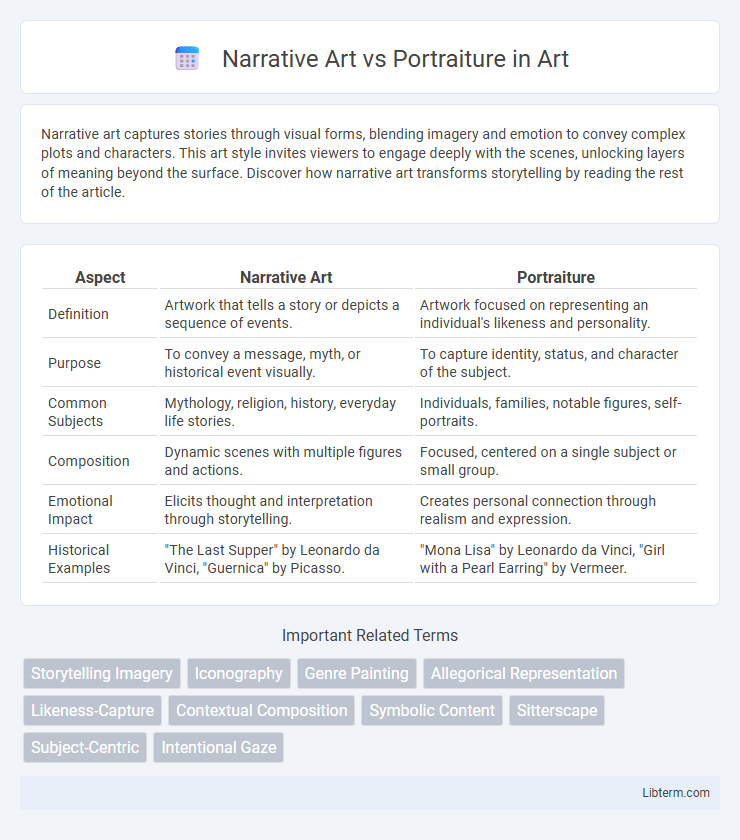Narrative art captures stories through visual forms, blending imagery and emotion to convey complex plots and characters. This art style invites viewers to engage deeply with the scenes, unlocking layers of meaning beyond the surface. Discover how narrative art transforms storytelling by reading the rest of the article.
Table of Comparison
| Aspect | Narrative Art | Portraiture |
|---|---|---|
| Definition | Artwork that tells a story or depicts a sequence of events. | Artwork focused on representing an individual's likeness and personality. |
| Purpose | To convey a message, myth, or historical event visually. | To capture identity, status, and character of the subject. |
| Common Subjects | Mythology, religion, history, everyday life stories. | Individuals, families, notable figures, self-portraits. |
| Composition | Dynamic scenes with multiple figures and actions. | Focused, centered on a single subject or small group. |
| Emotional Impact | Elicits thought and interpretation through storytelling. | Creates personal connection through realism and expression. |
| Historical Examples | "The Last Supper" by Leonardo da Vinci, "Guernica" by Picasso. | "Mona Lisa" by Leonardo da Vinci, "Girl with a Pearl Earring" by Vermeer. |
Understanding Narrative Art: Definition and Key Features
Narrative art conveys stories or events through visual imagery, often depicting sequences of actions or moments to communicate a broader message or moral. Key features include the use of symbolism, multiple figures, and dynamic compositions that guide the viewer through the unfolding narrative. Unlike portraiture, which focuses on capturing the likeness and personality of a single individual, narrative art emphasizes storytelling and context over individual identity.
Portraiture: An Exploration of Identity and Expression
Portraiture serves as a profound exploration of identity and expression, capturing not just physical likeness but also the subject's personality, emotions, and social status. This art form relies on techniques such as lighting, posture, and facial expression to convey deeper psychological and cultural narratives. Through sustained emphasis on individuality, portraiture transforms mere representation into a dynamic dialogue between the artist, subject, and viewer.
Historical Evolution: Narrative Art vs Portraiture
Narrative art evolved from ancient cave paintings and religious frescoes that depicted mythological and historical events, emphasizing storytelling through complex scenes and symbolic elements. Portraiture, originating in ancient Egypt and classical Greece, focused on individualized representation and personal identity, often reflecting social status and power. Over time, narrative art integrated more emotional and theatrical elements, while portraiture advanced toward realism and psychological depth, especially during the Renaissance and Baroque periods.
Techniques and Artistic Approaches Compared
Narrative art employs complex compositions and dynamic scenes to convey stories through symbolism, movement, and multiple figures, often utilizing techniques like chiaroscuro and perspective to enhance storytelling. Portraiture emphasizes detailed facial expressions, lighting, and texture to capture the sitter's personality and mood, focusing on individualized realism and emotional depth. Both approaches leverage brushwork, color schemes, and composition strategically, but narrative art prioritizes context and interaction, while portraiture centers on singular subject representation.
The Role of Storytelling in Narrative Art
Narrative art uses visual storytelling to convey complex sequences of events, emotions, and cultural values through imagery that unfolds a story over time. Unlike portraiture, which centers on capturing the likeness and personality of a single subject, narrative art integrates multiple figures, settings, and actions to communicate a broader narrative or historical context. This storytelling role enhances viewer engagement by inviting interpretation and emotional connection to the depicted scenes and themes.
Capturing the Individual: Portraiture’s Unique Purpose
Portraiture uniquely captures the essence of an individual by emphasizing personal identity, facial expression, and psychological depth, distinguishing it from narrative art that often prioritizes broader storytelling. This genre highlights subtle emotions and character traits, preserving the sitter's uniqueness and social context through fine detail and composition. The intimate connection between artist and subject in portraiture creates a powerful representation that resonates on both personal and cultural levels.
Emotional Impact: Conveying Meaning in Both Genres
Narrative art captures complex stories and emotions through detailed scenes, engaging viewers by illustrating dramatic moments and symbolic interactions that evoke empathy and reflection. Portraiture, by contrast, conveys emotional depth through the sitter's expression, posture, and eyes, offering an intimate glimpse into individual identity and psychological states. Both genres rely on visual cues and composition to communicate meaning, yet narrative art often emphasizes collective experience while portraiture highlights personal emotion.
The Influence of Culture on Narrative Art and Portraiture
Cultural context profoundly shapes both narrative art and portraiture by informing the symbols, themes, and stylistic conventions artists employ to communicate identity and stories. In narrative art, cultural myths, historical events, and societal values dictate the portrayal of scenes, emphasizing collective memory and shared experiences. Portraiture reflects cultural ideals of beauty, status, and personality, often revealing the socio-political environment and individual roles within a particular society.
Contemporary Trends in Narrative Art and Portraiture
Contemporary trends in narrative art emphasize immersive storytelling through multimedia and interactive installations, often exploring social and political themes that challenge traditional linear narratives. Portraiture has evolved to incorporate digital techniques and conceptual approaches, focusing on identity, representation, and the fluidity of self beyond mere likeness. Both forms increasingly blur boundaries, engaging audiences in participatory experiences that redefine the relationship between artist, subject, and viewer.
Collecting and Valuing: Market Perspectives on Both Genres
Narrative art commands strong interest among collectors due to its storytelling capacity and historical significance, often fetching high prices at auctions tied to cultural and thematic relevance. Portraiture remains a staple in the art market, prized for its intimate representation of individuality and societal status, with demand driven by both contemporary and classical works. Market trends indicate that while narrative art appeals to thematic collectors, portraiture consistently attracts investment from patrons valuing personal and historical resonance.
Narrative Art Infographic

 libterm.com
libterm.com